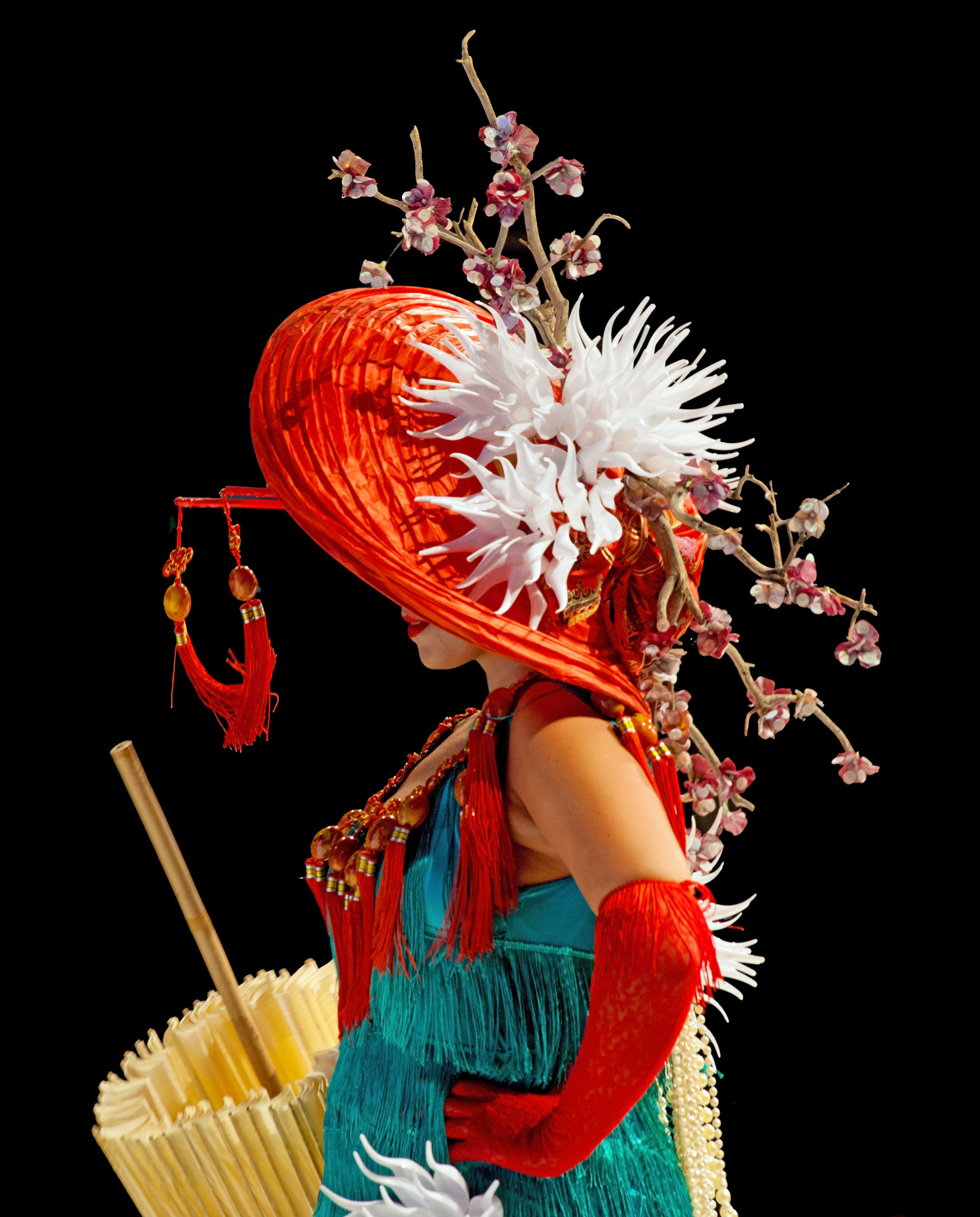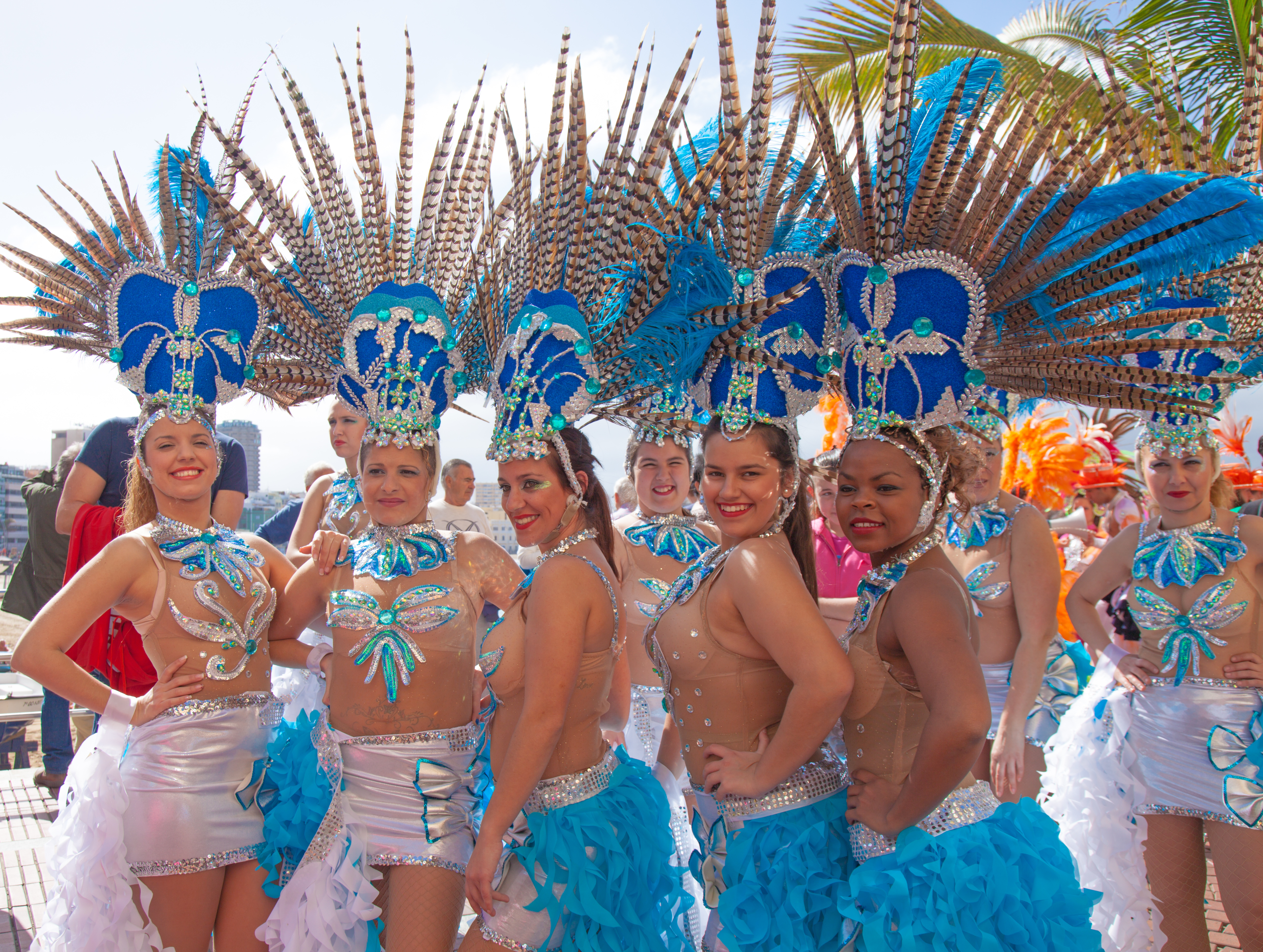By now we've been living on Gran Canaria for long enough to get a reasonably good idea of how the carnivals go here, and of course to take a decent amount of pictures. So I felt like writing it up. I've already done it once here, but now I know a little bit more.
Carnival happens in February.
Sometime in the autumn of the previous year the theme of the carnival is decided. After that a competition is announced for the main poster and set of imagery for the forthcoming carnival - I have never seen the announcement, but if it is an open call, it could be quite interesting to take part some time in the future.
Around November there is the Carnival Fashion Week. I don't know why it is called "week", since I am aware of only one event - the Carnival fashion show; with colorful (and generally silly) carnival fashion on display. The announced theme is important, but not absolutely essential.
 | |
| The hat is made of a collapsed lampshade ad the white flowers are made of plastic spoons... (my own pic submitted to Wikimedia) |
Official carnival site - http://lpacarnaval.com/en/
(It will eventually start showing the info for the next carnival. Right now, in March 2017, they are having a little break after the last one with no perceivable activity)
The full program is spread over a month.
The main carnival events start with a "Pregon", some singing and dancing followed by a small parade, all centered around Plaza de Santa Ana (in front of the Catedral de Santa Ana in Vegueta, the old town). The event is on the smaller side, but crowds are dense because it is the first.
Carnival includes a few stationary "Galas" which happen on the outdoor scene erected at the Santa Catalina Park. (A side effect of this is that the bus and bike stops on Santa Catalina don't work for over a month.) The most important are the The Carnival Queen Gala and Drag Queen Gala, where they are both elected from about a dozen finalists. Both events ticketed and not gratis; you can buy tickets either online or in the Tourist Information Center at Santa Catalina. You can, that is, but in my opinion you shouldn't - weather is not guaranteed, you may find yourself seated in a slippery plastic seat for a couple of hours under a drizzle (in case of really bad weather the events are re-scheduled), while watching a very mixed bag of performances. The galas are broadcasted on local TV as they happen.
Parties: there are a lot of them, most of them at night, between Santa Catalina Park and shopping center El Muelle; loud music and lots of beer. There are some daytime events, including some children-oriented with bouncy castles etc. The "Reina Infantil", a sort of Carnival Princess, is elected during her own "Gala" (same place).
Parades (the most interesting ones):
Children's Carnival Parade
 |
| Some kids are so funny. |
 |
| And some don't like the noise at all. I understand them. |
Las Canteras Carnival Parade: starts at one end of the town beach - La Puntilla, follows the promenade to the Auditorio (and shopping Center Las Arenas) with a side tour to Santa Catalina. Don't worry about knowing the exact route - just follow the noise, there is a lot of it.
Main Carnival Parade: Calle Leon y Castillo; starting from the level of the Floodlit Fontain (La Fuente Luminosa) and going to the port. Las Palmas has a complicated terrain; and Leon y Castillo is one of the essential streets. To minimize the disruption to the traffic, the parade is scheduled around 5 pm. It usually starts just a little late (but not the customary 45 min delay of Fuerteventura). In February, it means that the light is just starting to disappear. This year we were lucky to have sunshine at the beginning of the procession; the other two years were both cloudy with some rain. If you wish to take good pics of the Queen, the Dames and the Drag, position yourself at the beginning of the route, where there is a large plaza, on the side opposite to the sea, with the sun behind you.
(And please do move from place to place, don't be "that obnoxious photographer" whose back is present in every single photo. They do allow you to come right up to the participants, cross the road, etc.; use it. Yes, there was an especially annoying youtuber there this year).
Note that the dresses are being put together in front of the Perez Galdos theater at the beginning of Triana. Well, I say dresses, but I mean these contraptions on flatbed trucks where the beautiful ladies are inserted rather like an afterthought. So, the "fantasias" (the contraptions) are assembled in front of the theater, starting a couple of hours before the parade. The security tends to be very relaxed here too, so if you are interested you can come right up to them and look at the details. The ladies (and gentlemen) are dressed and make-up is applied at the same place. Shortly before the parade starts, they are rapidly whisked to the assembly point, so don't hang around right up to the last moment, you will miss the start of the parade otherwise.
 |
| Carnival Queen of 2015. As you can see, the dress as such consists essentially of a few sequinned straps, the rest being the "fantasia" |
 |
| Carnival Queen 2017. Ditto, with maybe just a little more material used to cover her more curvaceous figure. |
 |
| This year (2017) we were lucky with the weather for the main parade. If you know Las Palmas, you now know the place. |
The Burial of the Sardine: the parade ending on Las Canteras beach and the traditional closing ceremony with the burning of a large model of a sardine and a firework display at La Puntilla. It being a burial, it's a more sombre and somewhat less loud occasion, although not exactly quiet.
 |
| The carnival Queen dressed in mourning for the occasion |
 |
| Like the Drag Queen makeup on this one |
The explanations of "why the Sardine, why burial, why why why" will take a while, so I refer you to the wikipedia article. I was not aware of this tradition before coming to Spain. I just read that it is supposed to happen on Ash Wednesday (which follows Fat Tuesday, or Pancake day) - well, not here, where they take their Carnival very seriously. The Carnival doesn't finish on Wednesday and carries on till the weekend, so that is when the Burial happens.
Enjoy :)
Pics of Las Palmas Carnival on shutterstock - here















1 comment:
Post a Comment